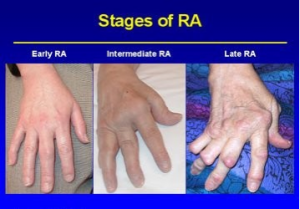Rheumatoid arthritis (RA) is a systemic autoimmune disease. It is characterized by inflammation of the membranes lining the joints.
Instead of the immune system protecting the body, it attacks itself. In RA, the immune system attacks the lining of the joints, called the synovium. RA is a long-term disease that leads to inflammation of the joints and surrounding tissues and can also affect other organs. These tissues include tendon sheaths, bursa, and tendons.
Signs and Symptoms of RA:
- Joint Pain: warmth, redness, tenderness, swelling
- Joint Stiffness: increased in the mornings
- Fatigue throughout the body
- Fever
- Weight Loss
- Rheumatoid Nodules: small lumps of tissue felt under the skin
- Symmetrical Patterns of affected joints
- Most common joints: wrist, hand, fingers, cervical spine, shoulder, elbow, knee, hip, foot, and ankle
- Prolong symptoms
- Anemia
- Neck Pain
- Dry Eyes
- Dry Mouth


Exercise with RA:
- Progressive Resistance Training (PRT) is an effective and safe intervention for stimulating muscle growth in patients with RA
- RCTs complying to the ACSM recommendations on PRT have found:
- ↑ in functional ability (Hakkinen et al., 1999; de Jong et al., 2004; Lyngberg et al., 1994)
- ↑ muscle strength (Hakkinen et al., 2004)
- No exacerbation of existing joint damage (de Jong et al., 2003; Hakkinen et al., 1994)
ACSM guidelines for training:
- Aerobic conditioning (30 to 60 minutes on five days per week)
- Resistance training (one set, major muscle groups, two times per week)
- Flexibility activities/exercises.
- Frequency – Be active on most days of the week but at least three to four days.
- Intensity – Exercise at a moderate level. Use the “talk test” to help you monitor.
- Type – Exercise in the water to reduce joint stress
Resistance exercise programs
- Frequency – At least two to three days per week. Plan a day of rest between sessions.
- Intensity – Light to moderate. Light intensity is weight you can lift 15 to 20 times. Moderate intensity is weight you can lift 10 to 15 times.
- Time – This depends on the number of exercises you do. In general, do one to three sets of 10 to 15 repetitions.
Benefits:
- Decreased joint pain and stiffness.
- Improved or maintained joint motion.
- Decreased risk of cardiovascular disease (higher in those with rheumatoid arthritis).
- Improved ability to do activities such as getting in and out of a car or going up and down stairs.
- Decreased disease activity.
- Resistance training helps reverse atrophy.
- PRT strengthens the muscles surrounding the joint. This reduces the risk of injury and more joint damage.
- PRT improves your ability to function and it also promotes overall good health.
Cautions:
- Exercise is uncomfortable for about 85 percent of people with RA. This will affect how much exercise you can do.
- Schedule your exercise each day when your pain is lowest. Also, plan to exercise when your pain medication is most effective.
- Avoid vigorous exercise during acute flare-ups or periods of inflammation. Instead, try gentle stretching exercises. These will help increase your range of motion.
- If you have been inactive for a long time, start with shorter sessions (10 to 15 minutes). Add five minutes to each session, increasing every two to four weeks. Over time, build up to being active at least 30 minutes a day on most days of the week.
- Expect some discomfort after your workouts. You should not be in pain, though. If pain is greater two hours after exercise than it was before, reduce the length and intensity of your next session.
- Total exercise time is more import than intensity. If you exercise at too high an intensity, you may not be able to exercise very long. This increases your risk of injury.
- Avoid vigorous, highly repetitive activities. This is especially true for people with unstable joints.
- Avoid overuse and repetitive stress injuries by alternating types of exercise over consecutive days.
- Drink plenty of fluids before, during, and after exercise.
